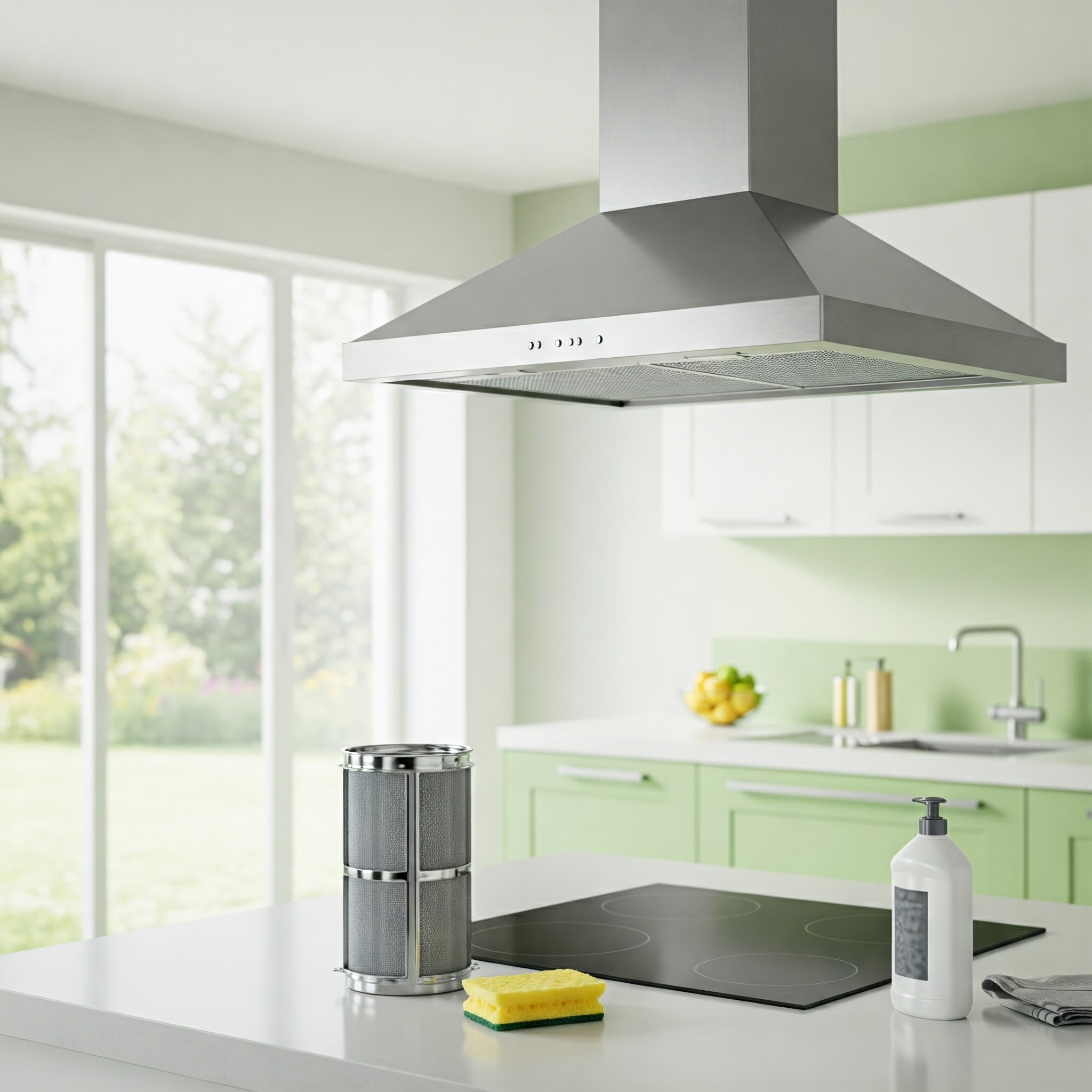How to Clean Chimney Oil at Home: A Complete Guide
Why Cleaning Your Chimney Matters
himney oil—grease, soot, and residue from cooking—builds up over time, especially if you frequently fry or cook oily dishes. A dirty chimney can:
- Reduce airflow, making it harder to clear smoke and odors.
- Attract pests and bacteria, affecting kitchen hygiene.
- Increase the risk of grease fires (a scary thought!).
- Shorten the lifespan of your chimney.
Regular cleaning saves you from costly repairs and keeps your kitchen safe. Plus, it’s easier than you think to do it at home with everyday items. Below, we’ll answer all your questions, from how to clean chimney filters at home to cleaning without chemicals.
Tools and Materials You’ll Need
Before you start, gather these affordable supplies:
- Dishwashing liquid or degreaser
- Warm water
- Soft scrub brush, sponge, or old toothbrush
- Microfiber cloths or clean rags
-
Dawn Ultra Dishwashing Liquid: A powerful degreaser for soaking filters and wiping down greasy parts.
- White vinegar and baking soda (for natural cleaning)
- Screwdriver (if removing parts)
- Gloves and a mask (to stay safe)
- Bucket or sink for soaking
- Optional: Chimney cleaning powder or commercial degreaser
- Dry cloth for wiping down
How to Clean Chimney Oil at Home: Step-by-Step Guide
Here’s a detailed guide covering all aspects of chimney cleaning, tailored to answer your specific questions.
1. How to Clean Chimney Oil at Home (General Cleaning)
Cleaning chimney oil involves tackling grease on filters, the interior, and the exterior. Follow these steps for a thorough clean:
- Step 1: Turn Off the Power
- Unplug the chimney or switch off the circuit breaker to avoid electrical hazards.
- Wear gloves and a mask to protect from grease and fumes.
- Step 2: Disassemble Removable Parts
- Check your chimney’s manual to locate detachable parts like filters or mesh.
- Use a screwdriver if needed to remove them carefully.
- Step 3: Clean the Parts (More on Filters Below)
- Soak filters and other greasy parts in a solution of hot water and dishwashing liquid for 15–30 minutes.
- Scrub gently to remove oil, then rinse and dry completely.
- Step 4: Wipe Down the Body
- Mix warm water with a few drops of dishwashing liquid or a degreaser.
- Use a sponge to wipe the chimney’s exterior and accessible interior surfaces.
- Dry with a microfiber cloth to prevent streaks or watermarks.
- Step 5: Reassemble and Test
- Put all parts back securely.
- Turn on the chimney to ensure it’s working properly.
Pro Tip: Clean every 1–3 months, depending on how often you cook oily foods, to prevent heavy buildup.
2. How to Clean Chimney Filter at Home
Chimney filters (baffle or mesh) trap most of the grease, so they need special attention. Here’s how to clean them effectively:
- Remove the Filter
- Detach the filter as per your chimney’s manual (usually by sliding or unscrewing).
- Lay it in a sink or bucket.
- Soak in a Cleaning Solution
- Mix hot water with dishwashing liquid (or a degreaser for stubborn grease).
- Soak the filter for 15–30 minutes to loosen oil.
- Scrub and Rinse
- Use a soft scrub brush or sponge to remove grease from all corners.
- For tough spots, an old toothbrush works wonders.
- Rinse thoroughly with warm water to remove soap residue.
- Dry Completely
- Air-dry or wipe with a clean cloth to prevent rust.
- Ensure it’s fully dry before reattaching to avoid mold.
Frequency: Clean filters every 1–2 months for optimal performance
3. How to Clean Chimney Filter at Home Without Chemicals
If you prefer eco-friendly methods, here’s how to clean chimney filters at home without chemicals:
- Vinegar Method
- Soak the filter in a 1:1 mix of white vinegar and hot water for 20–30 minutes.
- Scrub with a sponge to lift grease, then rinse well.
- Vinegar cuts through oil naturally and is safe for most filter types.
- Baking Soda Paste
- Mix baking soda with a little water to form a paste.
- Apply it to greasy spots, let it sit for 10 minutes, then scrub.
- Rinse thoroughly to remove residue.
- Lemon Juice for Odors
- Rub a lemon half over the filter after cleaning to neutralize smells.
- Rinse and dry as usual.
Why It Works: These natural ingredients are non-toxic, budget-friendly, and effective at breaking down grease without harming your chimney.
4. How to Clean Chimney Filter Without Removing
Sometimes, you may want to clean the filter without taking it out (e.g., for quick maintenance). Here’s how to clean chimney filter without removing:
- Vacuum Loose Debris
- Use a vacuum cleaner with a brush attachment to remove dust or loose grease from the filter’s surface.
- Wipe with a Degreaser
- Mix a small amount of dishwashing liquid with warm water.
- Dip a cloth or sponge in the solution, wring it out, and wipe the filter carefully.
- Avoid soaking the filter to prevent water from entering the chimney’s motor.
- Dry Immediately
- Use a dry microfiber cloth to absorb moisture and prevent rust.
Note: This method works for light grease but isn’t as effective as soaking. Remove and deep-clean the filter every few months for best results.
5. How to Clean Chimney Auto-Clean
Auto-clean chimneys use heat or oil collectors to reduce grease buildup, but they still need occasional cleaning. Here’s how to clean chimney auto-clean:
- Empty the Oil Collector
- Most auto-clean chimneys have a detachable oil collector cup.
- Remove it (check the manual for location) and empty the oil.
- Wash with dishwashing liquid and warm water, then dry completely.
- Clean the Filter (If Accessible)
- Some auto-clean models have filters you can remove and clean like standard ones (see filter cleaning steps above).
- If not removable, wipe the surface with a damp cloth and mild soap.
- Run the Auto-Clean Feature
- After reassembling, run the auto-clean function (if your model has it) to clear residual grease.
- Follow the manual’s instructions—usually, it involves pressing a button to heat the system.
- Wipe the Exterior
- Use a soapy cloth to clean the outside, focusing on greasy spots near the suction area.
Tip: Check the oil collector every 2–3 weeks and clean it to maintain efficiency.
6. How to Clean Chimney from Inside
Cleaning the chimney’s interior is trickier but necessary for thorough maintenance. Here’s how to clean chimney from inside:
- Access the Interior
- Remove filters and any detachable panels to expose the inner surfaces.
- Use a flashlight to spot greasy areas.
- Wipe Down Surfaces
- Mix warm water with dishwashing liquid or a degreaser.
- Use a damp sponge or cloth to wipe accessible areas, like the suction chamber.
- Avoid excessive water to protect electrical components.
- Clean Around the Motor (With Caution)
- If you can see the motor, use a dry or slightly damp cloth to gently remove dust or light grease.
- Never pour water near the motor—it can cause damage or electrical issues.
- Check for Blockages
- Look for debris clogging the suction path and remove it with a soft brush or vacuum.
Important: If the interior is heavily greasy or complex, consider hiring a professional to avoid damaging the chimney.
7. Chimney Cleaning Powder: What Is It and How to Use It?
Chimney cleaning powder is a commercial product designed to break down grease and simplify cleaning. Here’s how it works:
- What It Is
- A powdered degreaser that dissolves oil and soot, often used for filters and greasy surfaces.
- Available online or at hardware stores (brands vary by region).
- How to Use It
- Dissolve the powder in warm water as per the package instructions.
- Soak filters or apply the solution to greasy parts with a sponge.
- Scrub lightly, rinse well, and dry completely.
- Pros: Faster than soap for heavy grease; effective for stubborn stains.
- Cons: May contain chemicals, so use gloves and ventilate the kitchen.
Alternative: Stick to vinegar or baking soda for a chemical-free option if you’re concerned about fumes.
8. How to Clean Kitchen Chimney Outside
The chimney’s exterior affects your kitchen’s look, so keep it shiny! Here’s how to clean kitchen chimney outside:
- Prepare a Cleaning Solution
- Mix warm water with a few drops of dishwashing liquid or use a 1:1 vinegar-water mix for a natural option.
- Wipe Down Surfaces
- Dip a microfiber cloth or sponge in the solution and wring it out.
- Wipe the chimney’s outer body, focusing on greasy spots near the buttons or edges.
- For stainless steel chimneys, wipe in the direction of the grain to avoid scratches.
- Tackle Stubborn Stains
- Apply a baking soda paste to tough grease marks, let it sit for 5 minutes, then wipe off.
- Rinse with a damp cloth to remove residue.
- Polish for Shine
- Dry with a clean microfiber cloth to prevent watermarks.
- Optional: Use a small amount of olive oil on a cloth to add shine to stainless steel surfaces.
Tip: Wipe the exterior weekly to prevent grease from hardening.
Maintenance Tips to Prevent Chimney Oil Buildup
To make cleaning easier and keep your chimney in top shape:
- Clean filters every 1–2 months and the oil collector (for auto-clean models) every 2–3 weeks.
- Run the chimney at the right speed: high for frying, low for boiling.
- Wipe the exterior weekly with a damp cloth to stop grease from sticking.
- Schedule a professional deep clean once a year for hard-to-reach areas.
- Use splash guards or lids while cooking to reduce oil splatter.
Safety Precautions
To make cleaning easier and keep your chimney in top shape:
- Clean filters every 1–2 months and the oil collector (for auto-clean models) every 2–3 weeks.
- Run the chimney at the right speed: high for frying, low for boiling.
- Wipe the exterior weekly with a damp cloth to stop grease from sticking.
- Schedule a professional deep clean once a year for hard-to-reach areas.
- Use splash guards or lids while cooking to reduce oil splatter.
Conclusion
Cleaning chimney oil at home doesn’t have to be a chore! Whether you’re scrubbing filters, wiping the exterior, or maintaining an auto-clean model, these DIY methods—using everyday items like vinegar, baking soda, or dish soap—make it easy and affordable.
By following this guide, you’ll enjoy a cleaner kitchen, better chimney performance, and peace of mind knowing you’ve reduced fire risks. Try these tips today, and let us know how they worked for you!
Have a favorite cleaning hack? Share it in the comments below.



